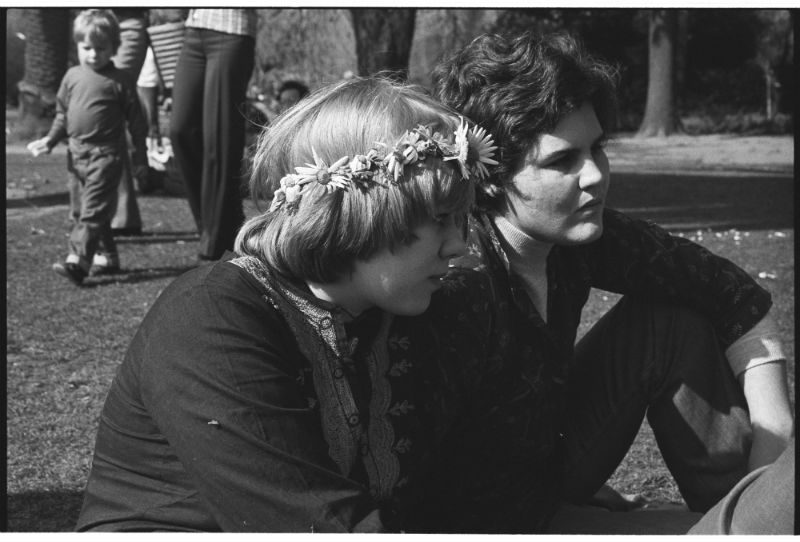Stretch your mind back to the 1900s, when lesbian desire meant you were medically insane and likely to be dragged off to the asylum.
Cast your mind across everything you know about lesbians in history. In particular, Australian history. You might be able to name one or two lesbians, bisexuals or queer women from the 1900s, if you’re in the know.
Otherwise, it’s a pretty bleak and sparse canvas, especially in reference to mainstream representations of lesbian desire. Add questions about our Indigenous lesbian history and the answers are even harder to come by (pun intended). The Gays and Lesbians Aboriginal Alliance call this the Empty Mirror.
Lesbians, and women who desired each other before the term lesbian even existed, have always been culturally invisible. They slip under the historical radar.
What we do know is that in Australia, according to the rule of law, lesbians were thought not to exist. Taking it on the clit has never been a crime. In fact, the laws against homosexuality only applied to anal sex. Why? Women were thought not to have desire like men do, let alone desire each other. Yet there are court records of female convicts in 1841 describing “nailing” each other, according to historian Eleanor Conlin Casella.
Despite this, women having sex or otherwise desiring each other were thought to be unholy bonds and, quite simply, a sin.The 1950s spun around and women who didn’t fit models of what it is to be feminine – that may have dressed in men’s clothing, behaved liked men and desired ‘like men’- were often admitted to the asylum or the mental hospital as mad and called men-women, according to historian Ruth Ford. Failed heterosexuals were a medical problem.
By the 1960s, homosexuality was thought to be a curable disease, and therefore ideas moved from punishing the person to trying to cure them. A personality disorder or neurotic condition was what we had. Those lovers of the now acclaimed TV show Masters of Sex,will know that drug treatments and electro-convulsive therapy were considered legitimate treatments. According to the ideas at the time, it was all your family’s fault. If your mum was dominant – LESBIAN. If your dad was passive and gentle – LESBIAN. Talk about reinforcing gender stereotypes.
The political movements of the 1970s marched in and questioned the treatment of gay, bisexual, transgender and lesbian people and along with it, the very idea that sexual desire for someone of the same sex was a sickness.
Thank fuck. According to Emily Wilson, The Campaign Against Moral Persecution (CAMP – ha!) in Sydney played a vital and pioneering role in challenging so-called homosexuality experts. In 1973 homosexuality was removed from the American Psychiatric Association’s manual, to great protest.
Pan through the lesbian icons in popular culture we have had since the pivot from being curable to just plain sexual, and there aren’t a load, but there are some. Ellen, who came out on her show of the same name in 1997, only for it to be slapped with a parental advisory warning, later cancelled and fell into obscurity. Until, that is, she rose to become the TV host and interviewer the world now loves almost as much as Oprah.Buffy explored same-sex love, also in 1997, but came to prominence as a cult classic later.
The L Word came along in 2004 to the relief of white, middle-class femme lesbians and the women who love them. Lip Service followed with a Scottish version in 2010. Lost Girl was the bisexual answer to The L Word in 2010. Wentworth banged on the jail cell in 2013, then Orange is the New Black dragged its metal cup across all our lips, also in 2013. Are you sensing a theme here?
We’ve come from the asylum, but, it seems, the cell is where the lesbian as a character has its most potent public outing.
Is there a respectable lesbian character to be found on our TV screens, or is the lesbian in public life still deviant in a way that the gay dads on Modern Family aren’t? I reckon so. But I don’t think that’s an entirely bad thing either.
There’s lots of debate at the moment about what the LGBTI movement is and what it should stand for. Should it be assimilated into mainstream ideas of marriage and family? Or should it retain its activist beginnings, standing proudly outside normative ideas about sex, desire and what constitutes a family? I don’t have a definitive answer, but I think the lesbian as a cult hero – as a historical icon – drips with the questions and the answers.
Whatever your position, there’s no denying that while the pop cultural Lesbian may be the new black, she’s still deviant as fuck. And I kinda like that. But it also makes me wonder how far we’ve got to go before the Lesbian makes it out of the shackles of history, into something a little more fitting, and I’m not talking about a little black dress.
